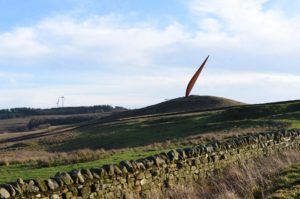At the time of her death on September 8, 2022, most people on earth had not known another Queen of England apart from Elizabeth II. With the Second Elizabethan era concluded, no doubt the United Kingdom will soon be littered with statues and monuments bearing the Queen‘s likeness. Charles III already got the ball rolling when he unveiled a life-size statue of his late mother at York Minster in November 2022. However, some tributes to the Queen may not look like her but will be dedicated to her nonetheless. One such monument is already in the planning stage in northern England, designed by the abstract sculptor Simon Hitchens.
Even before the Queen’s death, plans were underway for the large sculpture Ascendant, dedicated to Elizabeth II. The sculpture will be erected on the Viscount Devonport’s Ray Demesne estate in Northumbria, about 23 miles northwest of Newcastle. According to Hitchens’s designs, Ascendant will be absolutely enormous, looking like a giant, industrial-style feather protruding from the top of the hill at an angle. According to Hitchens, the shape of the sculpture was inspired by a steam turbine blade. In his concept drawings, the steel structure rises from the hill with a large seam dug out in front of it, almost as if the structure is a slice of the earth itself being raised up. This blade will have ninety-six fins on each side, one for each year of Queen Elizabeth II’s life.
Ascendant, also known as the Elizabeth Landmark, has encountered significant opposition, particularly from a group called Keep the Wannies Wild. Statements made by that organization call the proposed sculpture “invasive”. This may remind some of another public artwork in the United Kingdom, especially since this part of England is not unfamiliar with large public sculptures. Antony Gormley’s Angel of the North was completed just south of Newcastle in 1998. Gormley’s work stands over sixty-five feet tall. Ascendant, however, will stand almost three times that size at one hundred eighty feet tall. Like Ascendant, the Angel of the North also received some pushback from local groups, claiming it would be an eyesore or a distraction for nearby drivers. However, they were all proven wrong when the Angel of the North became a local landmark, one of Britain’s most iconic public artworks, and one of the most recognizable symbols of northern England. But some are ready to point out the differences between the two projects. Angel of the North, for example, is close to a main road less than five miles south of Newcastle’s city center. Ascendant will be located in a rather remote area, with the nearest town being Kirkwhelpington, a small village of less than five hundred people.
Those in favor of Ascendant’s construction say it would help revitalize the area, bringing in tourists and boosting local businesses heavily hit by the effects of Covid. Trevor Thorne, the vice-chair of Northumberland’s planning committee, seems to be on the project’s side. He says that the hilly countryside surrounding Newcastle “is such a special place but, beyond the local area, it is a bit of a secret. Something like this could really draw people here to enjoy that wild beauty.” The project team estimates that Ascendant will likely cost around £3 million. Official fundraising efforts will begin later this year.

